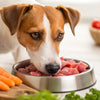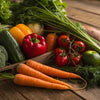Is Raw Dog Food Cooked? Understanding the Cooking Debate for Optimal Pet Nutrition
- Houndsy
Table of Contents
- Introduction
- The Rise of Raw Dog Food Diets
- The Case for Cooking Dog Food
- Comparing Raw and Cooked Diets
- Innovations in Pet Nutrition: The Houndsy Approach
- FAQs About Raw Versus Cooked Dog Food
- Conclusion
Introduction
Feeding our beloved canine companions can feel like a never-ending maze of choices. With discussions swirling around raw versus cooked dog food diets, many pet owners find themselves pondering a compelling question: Is raw dog food cooked? This question serves as a gateway into a broader conversation about what constitutes the healthiest choice for our dogs.
Pet nutrition has become a hot topic among dog lovers, with more owners looking to personalize their pets' meals and elevate their overall well-being. A recent survey indicated that nearly 60% of dog owners are considering fresh food options over traditional kibble. Understanding the balance between raw and cooked diets can not only help us provide the best for our furry friends but also improve their health, digestion, and happiness.
In this blog post, we will dissect the raw versus cooked dog food debate, exploring the nuances, implications, and what ultimately might be the right choice for your furry family member. By the end of this article, we aim to clarify the differences between raw and cooked food diets while also emphasizing our commitment at Houndsy to enhance the feeding experience through our innovative products, such as the Houndsy Kibble Dispenser.
The Rise of Raw Dog Food Diets
Fresh, raw dog food is rapidly gaining popularity, with advocates claiming it promotes better health and vitality for dogs. The foundation for this popularity is rooted in the belief that raw diets replicate the ancestral eating patterns of canines. Here’s a closer look at the idea behind raw feeding:
Nutrient Preservation
Raw food retains natural enzymes, vitamins, and amino acids that cooking can destroy. These nutrients are vital for maintaining digestive health and supporting the immune system. A raw food diet often consists primarily of raw meat, bones, and some fruits and vegetables, ensuring dogs receive a wide range of essential nutrients.
Biologically Appropriate Nutrition
Many advocates argue that a raw diet is more aligned with a dog's evolutionary past, resembling what they would eat in the wild—raw meat and bones. This instinctual preference for raw food ties back to their predatory ancestry, mimicking the diet of wolves.
Real-World Example
One advocate of raw feeding reported significant improvements in their dog's coat condition and energy levels after transitioning from kibble to a raw diet, citing a shinier coat and increased playfulness as key benefits.
Digestive Support
Proponents claim that raw diets can alleviate various digestive issues. Natural enzymes found in raw meat can assist in breaking down food, easing the digestive burden on dogs that may be sensitive to processed foods.
The Case for Cooking Dog Food
While raw diets have their appeal, the cooking debate is equally compelling. Cooked dog food offers several advantages, particularly concerning safety, digestibility, and palatability.
Elimination of Pathogens
A critical advantage of cooking dog food is the elimination of harmful bacteria such as Salmonella and E. coli. These pathogens pose significant health risks not only to dogs but also to humans handling raw diets. For families with young children or elderly relatives, this aspect is crucial for preventing cross-contamination in the home.
Enhanced Digestibility and Nutrient Absorption
Cooking can make meat and other ingredients more digestible. Gently cooked foods often incorporate a balance of protein and vegetables, promoting better fiber intake, which aids digestion. For many dogs, especially those with sensitive stomachs, cooked diets can offer a more suitable alternative.
Customer Insights
Many dog parents transitioning their pets from kibble to cooked meals report smoother digestion and increased acceptance of food, demonstrating that the warmth and aroma of cooked meals can enhance the eating experience significantly.
Increased Palatability
One often-overlooked benefit of cooking is its ability to boost the flavor and aroma of pet food. Dogs are instinctively drawn to the scent of cooked meals, which can be particularly beneficial for picky eaters. A gentle cooking process keeps essential flavors intact while making meals more appealing.
Comparing Raw and Cooked Diets
As we weigh the benefits of raw versus cooked diets, it’s essential to understand the considerations and potential downsides of each option.
Health Risks and Concerns
-
Raw Feeding Risks: With a raw diet, the primary concern revolves around pathogens. Proper handling and storage become vital, requiring pet owners to stay vigilant about cleanliness and food safety.
-
Cooked Food Limitations: While cooking can damage some heat-sensitive nutrients, many high-quality cooking methods, like sous-vide, help preserve essential vitamins and minerals.
Nutritional Balance
Raw feeding requires a careful balance of nutrients and careful sourcing to ensure all necessary components are included—something that can be challenging for some pet owners. Conversely, cooked food often offers a convenient formulation, ensuring a well-rounded diet is achieved more effortlessly.
Hypothetical Case Study
Consider a pet owner who decides to invest in both raw and cooked options. They found that their dog thrived on a largely cooked diet, but supplemented with occasional raw treats. This combination allowed for flexibility while meeting their dog's nutritional needs.
Innovations in Pet Nutrition: The Houndsy Approach
At Houndsy, we recognize the importance of the feeding experience for both pets and their owners. We believe in design excellence and functionality, emphasizing the convenience of our flagship product, the Houndsy Kibble Dispenser.
Simplifying the Feeding Process
Our dispenser is designed to simplify pet feeding, allowing pet owners to serve the perfect portion every time without bending down, ensuring both convenience and ergonomic comfort. With a storage capacity of up to 30 lbs, it provides an elegant yet practical solution for storing dry dog food, minimizing mess.
Quality Assurance
Whether you opt for raw or cooked options, it’s crucial to prioritize quality. Our dispenser features a BPA-free liner to keep your kibble fresh. This component complements our commitment to pet well-being and integrity, ensuring your dog’s meal retains its nutritional integrity.
Catering to Design-Conscious Pet Parents
With a sleek mid-century modern aesthetic, our Kibble Dispenser aligns with sophisticated home decor while meeting the practical needs of pet owners. We take pride in making not just functional pet care products, but also beautiful ones.
Call to Action
Interested in elevating your dog feeding experience? Discover the Houndsy Kibble Dispenser for yourself and see how it can transform mealtime: Houndsy Kibble Dispenser.
FAQs About Raw Versus Cooked Dog Food
1. Can I combine raw and cooked food in my dog's diet?
Absolutely! Many dog owners successfully blend raw and cooked options to create a balanced diet. However, be sure to monitor your dog's reaction and adjust accordingly.
2. How can I ensure my dog's raw diet is safe?
Invest in high-quality ingredients, source from reputable suppliers, and implement strict hygiene practices when handling raw food.
3. What are the signs that a diet is not working for my dog?
Look for symptoms such as vomiting, diarrhea, changes in appetite, lethargy, or significant weight loss. If you observe these signs, consult your veterinarian for guidance.
4. How do I choose the best diet for my dog?
Consider your dog's individual needs, health conditions, and preferences. It may also be beneficial to consult with a veterinarian or a pet nutritionist for tailored advice.
5. Do dogs naturally prefer raw over cooked?
Preferences can vary widely among individual dogs. Some may enjoy the texture and taste of raw, while others might prefer the warmth and aroma of cooked food.
Conclusion
The great raw versus cooked debate in dog food truly reflects our ever-evolving understanding of canine nutrition. At Houndsy, we advocate for a thoughtful approach that puts your dog's health and happiness first, irrespective of the feeding method you choose. By genuinely understanding your dog's dietary needs and preferences, you can provide a meal experience that is not only nutritious but also enjoyable.
Whether you’re considering a raw diet, embracing home-cooked meals, or enhancing your feeding routine with the Houndsy Kibble Dispenser, we encourage you to explore how these nutritional choices can positively impact your pet’s life. Let’s make mealtime a delightful experience for our furry companions—after all, they deserve the best we can offer!












